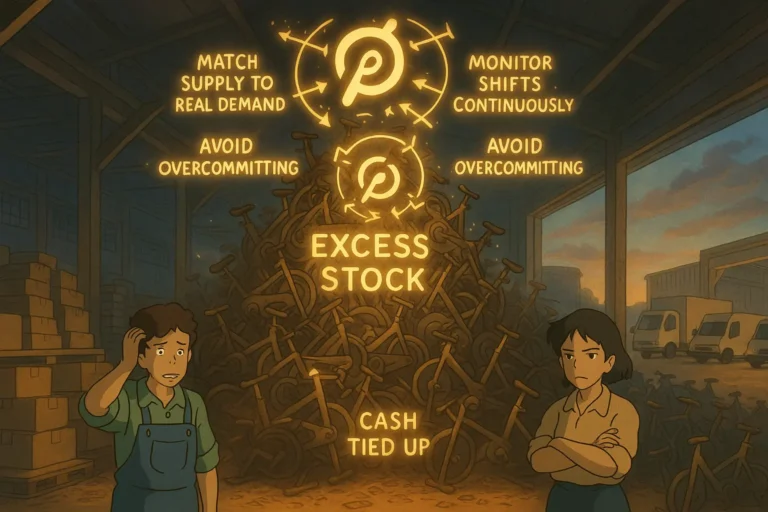
When out of control, inventory holding costs can paralyze supply chain operations anywhere, but in this article, we will emphasize Africa.
This is because of the amount of capital tied down. It doesn’t matter whether it is with the raw materials or the finished goods.
Tied-down inventory is never a good thing, especially when the supply chain or organization has a limited cash flow.
In this article, we will explore strategies that can be leveraged to reduce the inventory holding cost of the supply chain.
What is Inventory Holding Costs?
Simply put, inventory holding cost is the amount of money tied down in your supply chain’s inventory. It is the amount of capital channelled towards the maintenance and storage of inventory.
Your inventory holding cost combines the following expenses: warehousing, storage space, insurance, security, depreciation, and the opportunity cost of tying up capital in unsold goods.
This cost can get out of control. It is typically the case when there is poor planning.
Why Supply Chains in Africa Reduce Inventory Holding Costs
There are definite benefits to reducing your inventory holding costs.
𝟭. 𝗖𝗼𝘀𝘁 𝗦𝗮𝘃𝗶𝗻𝗴𝘀: Low holding costs immediately result in lower operating costs, which raises total profitability.
𝟮. 𝗪𝗼𝗿𝗸𝗶𝗻𝗴 𝗖𝗮𝗽𝗶𝘁𝗮𝗹: Lower inventory holding costs free up working capital, which can be allocated to other financial needs within the supply chain.
𝟯. 𝗖𝗼𝗺𝗽𝗲𝘁𝗶𝘁𝗶𝘃𝗲 𝗔𝗱𝘃𝗮𝗻𝘁𝗮𝗴𝗲: Businesses can increase market share and draw in more customers by offering more competitive prices.
𝟰. 𝗥𝗶𝘀𝗸 𝗠𝗶𝘁𝗶𝗴𝗮𝘁𝗶𝗼𝗻: Lower inventory levels minimize operational and financial risks by lowering the chance of theft, damage, and obsolescence.
𝟱. 𝗢𝗽𝗲𝗿𝗮𝘁𝗶𝗼𝗻𝗮𝗹 𝗘𝗳𝗳𝗶𝗰𝗶𝗲𝗻𝗰𝘆: Cutting waste and simplifying procedures are two ways that lowering surplus inventory improves operational efficiency.
𝟲. 𝗦𝘂𝘀𝘁𝗮𝗶𝗻𝗮𝗯𝗶𝗹𝗶𝘁𝘆: Since lower inventory levels demand fewer resources and storage space, they have a smaller environmental impact.
How to Supply Chains In Africa Can Reduce Inventory Holding Costs
These are the strategies that will help you in reducing your supply chain’s inventory holding costs.
1. Demand Forecasting
Often, supply chains in Africa are limited because of their inability to predict the customer’s demands correctly. This could lead to overstocking and sometimes stockouts.
These supply chains are hardly on track with what the customers want. That is why many of them experience issues with their inventory.
By integrating or implementing demand forecasting, the supply chain can better predict market demands and adjust production and other supply infrastructures to match.
This way, they reduce the risk of having excessive inventory in their possession, freeing up more cash for the supply chain.
Many supply chains on the continent fear demand planning and forecasting systems. This is primarily because of the cost of implementation and expertise needed. However, there are cheaper, albeit stressful options, such as market surveys.
Although the cost can be on the high side in many cases, the benefits outweigh the potential issues.
2. Optimizing Safety Stocks
Safety stocks are essential for spikes in demand that the demand forecasting systems cannot pick up. However, it can become excessive, and that causes problems.
Your safety stock serves as a bridge rather than a mountain of bills for your supply chain. It doesn’t make sense to have too much of it, especially when there is a demand forecasting system in place.
There has to be a sweet spot, which is why optimizing safety stock is crucial. When optimized, the safety stock is just enough to meet potential spikes, but at the same thing, it does not cause problems for the supply chain.
An optimized safety stock is also constantly rotated to avoid damages, which only incurs more costs for the supply chain. It is one of the easiest ways supply chains in Africa can reduce inventory holding costs.
3. Get Rid of Dead Stock
Dead stocks are a problem for many supply chains. Simply put, they are products the supply chain cannot sell for several reasons.
It could be damages, market rejection, or the wrong season. Whatever the reason is, the result is the same. They are taking up space and costing the supply chain money every day.
This is why getting rid of it is important. There are a few ways a supply chain can do this. It could be done through promotions, clearance sales, donations, repurposing, or destruction.
There is no shortage of options, but finding the right one for your supply chain could be complicated. It depends on the nature of the product, the type of business, and the cost involved.
Getting rid of dead stocks streamlines operations, frees up cash, and repurposes warehouse infrastructures. However, to prevent it from happening again, there has to be a deliberate effort only to make or sell products the market wants or needs.
Factors to Consider When Reducing Inventory Holding Costs in Africa
There are factors you have to consider in trying to reduce inventory costs in your supply chain.
- Local Market Demand
- Infrastructure and Transportation
- Supply Chain Resilience
- Regulatory Environment
- Economic Conditions
- Local Suppliers
- Product Shelf Life
- Local Inventory Control
- Supplier Negotiations
- Inventory Optimization Tools
- Local Culture and Customs
- Collaboration
- Lean Practices
- Inventory Segmentation
- Education and Training
- Sustainability
Challenges Supply Chains in Africa Face When Reducing Inventory Holding Costs
𝟭. 𝗗𝗲𝗺𝗮𝗻𝗱 𝗩𝗮𝗿𝗶𝗮𝗯𝗶𝗹𝗶𝘁𝘆: Inaccurate demand forecasting can affect supply chains when there are fluctuations in demand. This can result in overstocking or stockouts, which impacts the ability to reduce inventory holding cost
𝟮. 𝗟𝗶𝗺𝗶𝘁𝗲𝗱 𝗜𝗻𝗳𝗿𝗮𝘀𝘁𝗿𝘂𝗰𝘁𝘂𝗿𝗲: Holding costs may increase due to inefficiencies in areas with insufficient infrastructure for storage and transportation.
𝟯. 𝗘𝗰𝗼𝗻𝗼𝗺𝗶𝗰 𝗩𝗼𝗹𝗮𝘁𝗶𝗹𝗶𝘁𝘆: Inflation and currency swings can have an impact on the price of goods as well as the expenses associated with keeping inventory.
𝟰. 𝗢𝗽𝗲𝗿𝗮𝘁𝗶𝗼𝗻𝗮𝗹 𝗗𝗶𝘀𝗿𝘂𝗽𝘁𝗶𝗼𝗻𝘀: Uncertainty in politics, the weather, and other events can impair the supply chain’s dependability and raise the need for safety stock.
FAQs on Reducing Inventory Holding Costs for Supply Chains Across Africa
Let’s explore some Frequently asked questions on reducing the holding cost of supply chains on the continent.
Q1. In an African supply chain, how can I maximize inventory levels to lower holding costs?
To maintain ideal inventory levels, use inventory optimization models, estimate local demand, and monitor lead times.
Q2. How does demand in the local market contribute to lower inventory holding costs in Africa?
It’s critical to adjust inventory levels to account for seasonality and local demand patterns to avoid overstocking or understocking.
Q3. How can I reduce the expense of keeping inventory on hand by navigating Africa’s regulatory environment?
To maintain compliance and reduce delays, keep current on local laws, customs processes, and import/export limitations.
Conclusion
Reducing inventory holding costs in the supply chain is an essential process in optimizing the inventory. With the strategies highlighted here, your supply chain can free up cash.

Obinabo Tochukwu Tabansi is a supply chain digital writer (Content writer & Ghostwriter) helping professionals and business owners across Africa learn from real-world supply chain wins and setbacks and apply proven strategies to their own operations. He also crafts social content for logistics and supply chain companies, turning their solutions and insights into engaging posts that drive visibility and trust.








